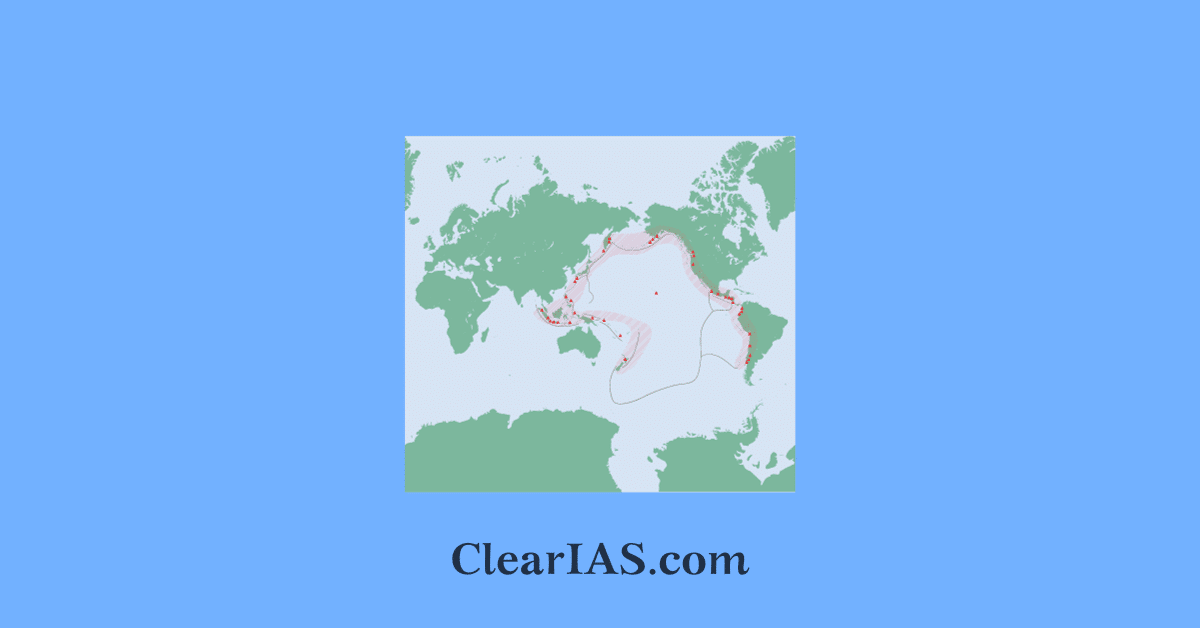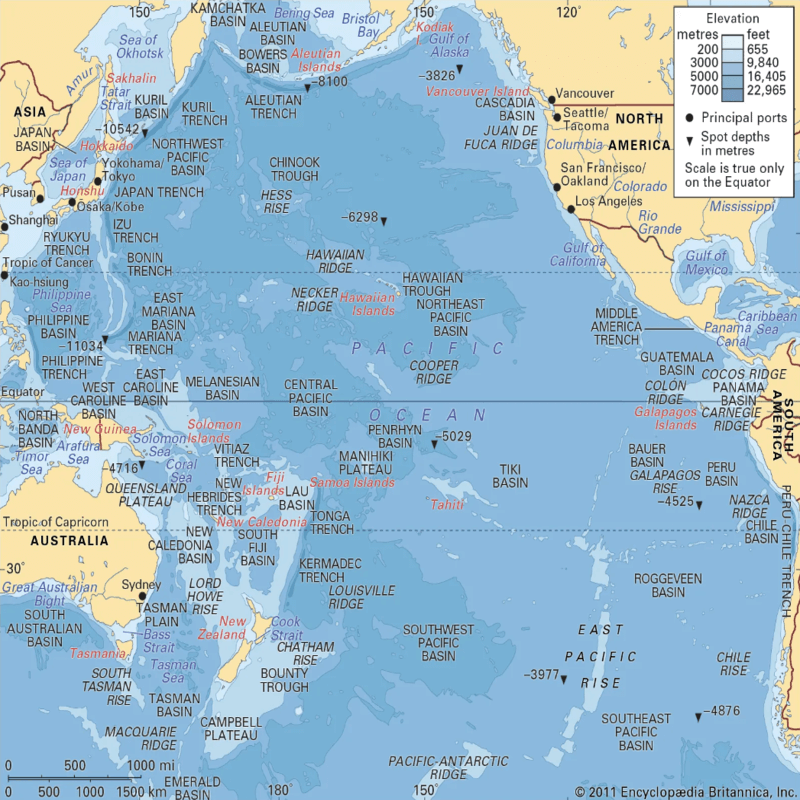
The bottom topography of the Pacific Ocean is influenced by its tectonic activity, including subduction zones, mid-ocean ridges, and hotspot-related volcanic activity. Read here to learn more.
The diverse array of geological features contributes to the Pacific Ocean’s unique biodiversity and plays a crucial role in shaping global ocean circulation patterns and climate dynamics.
The Pacific Ocean serves as a vital route for international trade, with busy shipping lanes connecting Asia to the Americas and Oceania. The Panama Canal and the Suez Canal are key passages for ships traveling between the Pacific and other oceans.
Pacific Ocean
The Pacific Ocean is the largest and deepest of Earth’s oceans, covering more than 60 million square miles (about 165 million square kilometers) and accounting for more than one-third of the world’s total ocean area.
It is known for its immense size, diverse marine life, and critical role in global climate and weather patterns.
- The Pacific Ocean is the largest of the world’s five oceans, surpassing the combined size of all the Earth’s landmasses.
- It extends from the Arctic Ocean in the north to the Southern Ocean in the south and is bounded by the continents of Asia and Australia to the west and the Americas to the east.
The Pacific Ocean is home to an incredibly diverse range of marine life, including coral reefs, fish, marine mammals, and seabirds. It contains numerous marine ecosystems, such as the Great Barrier Reef in Australia and the Coral Triangle in Southeast Asia.
The Pacific Ocean has a significant impact on global climate patterns through phenomena like El Niño and La Niña. These events involve the periodic warming (El Niño) and cooling (La Niña) of surface waters in the tropical Pacific, affecting weather conditions worldwide.
The Pacific Ocean is dotted with thousands of islands and island chains, many of which are volcanic or coral atolls. Notable island groups include the Hawaiian Islands, Fiji, Samoa, the Solomon Islands, and the Philippines.
The Pacific Ocean hosts several major ocean currents, including the North Pacific Current, the California Current, and the South Equatorial Current. These currents play a crucial role in global climate circulation and can impact weather and climate in coastal regions.
The Pacific Ring of Fire is a region surrounding the Pacific Ocean known for its high volcanic and seismic activity. Many of the world’s earthquakes and volcanic eruptions occur in this area.
Also read: Pacific Decadal Oscillation
Bottom topography of the Pacific Ocean

The Pacific Ocean, the largest and deepest of the world’s oceans, exhibits a complex and varied bottom topography. This topography includes deep trenches, seamounts, ridges, basins, and plateaus.
North Pacific Ocean
The North Pacific Ocean encompasses the area north of the equator and includes several subregions:
- Bering Sea: Located between Alaska and Russia, the Bering Sea is known for its rich marine life and is an important fishing area.
- Sea of Japan (East Sea): This semi-enclosed sea lies between Japan and the Korean Peninsula.
- North Pacific Subtropical Gyre: This is a large system of rotating ocean currents in the subtropical North Pacific. The North Pacific High-pressure system dominates this region, resulting in relatively calm and dry conditions.
- Gulf of Alaska: Situated between the southern coast of Alaska and the Aleutian Islands, this area is characterized by the convergence of cold, nutrient-rich waters from the north and warm currents from the south.
Central Pacific Ocean
The Central Pacific Ocean lies between the North and South Pacific and includes the following subregions:
- Hawaiian Islands: This archipelago is one of the most famous in the world and is located in the central North Pacific.
- Equatorial Pacific: This region near the equator includes the Line Islands and the Kiribati atolls.
- Marshall Islands and Federated States of Micronesia: These island nations are located in the central and western equatorial Pacific.
South Pacific Ocean
The South Pacific Ocean includes a vast area of ocean south of the equator, comprising numerous island nations and territories:
- Polynesia: This region includes islands such as Tahiti, Samoa, Tonga, and the Hawaiian Islands. It extends from Hawaii in the north to New Zealand in the south.
- Melanesia: Encompassing islands like Papua New Guinea, Fiji, and the Solomon Islands, Melanesia is located to the west and southwest of Polynesia.
- Micronesia: Situated in the western Pacific, Micronesia includes islands like Guam, the Northern Mariana Islands, and the Federated States of Micronesia.
Western Pacific Ocean
The Western Pacific Ocean is the region to the west of the International Date Line and includes:
- Philippine Sea: An extension of the western Pacific, this sea is located between the Philippines and Taiwan.
- East China Sea: Situated between China, Taiwan, and Japan, this sea is part of the northwestern Pacific Ocean.
Eastern Pacific Ocean
The Eastern Pacific Ocean includes the region off the western coast of the Americas, from North America to South America.
- California Current: This is a cold ocean current that flows southward along the western coast of North America, influencing the climate and marine ecosystems of the region.
- Peru Current: Also known as the Humboldt Current, this cold ocean current flows northward along the western coast of South America.
Trenches
- Mariana Trench: The Mariana Trench, located in the western Pacific, is the deepest part of the world’s oceans. The trench reaches a maximum known depth of approximately 36,070 feet (10,994 meters) at a point called the Challenger Deep. It is the result of the subduction of the Pacific Plate beneath the Mariana Plate.
- Philippine Trench: Situated to the east of the Philippines, this trench is another deep subduction zone in the western Pacific Ocean.
- Japan Trench: Found off the eastern coast of Japan, the Japan Trench is a subduction zone created by the Pacific Plate diving beneath the North American Plate. It is associated with seismic activity and tsunamis.
- Tonga Trench: Located in the southwestern Pacific, the Tonga Trench is another subduction zone where the Pacific Plate subducts beneath the Tonga Plate.
- Peru-Chile Trench: Running along the western coast of South America, this trench is a subduction zone where the Nazca Plate is subducting beneath the South American Plate.
East Pacific Rise
- The East Pacific Rise is a mid-ocean ridge system that runs north-south along the eastern Pacific Ocean floor.
- It is a divergent plate boundary where the Pacific Plate and the Nazca Plate are moving apart, leading to volcanic activity and the formation of new oceanic crust.
- A minor ridge known as Galapagos Ridge runs parallel to the East Pacific Ridge in the east between the Eastern Island Fracture Zone and Galapagos islands.
Hawaii-Emperor Seamount Chain
- This seamount chain extends from the Hawaiian Islands in the northeast to the Emperor Seamounts in the northwest.
- It is the result of the Pacific Plate moving over a hotspot, leading to the formation of volcanic islands and seamounts.
Bottom Topography of Pacific Ocean: Other features
Tuvalu and Kiribati Atolls: These low-lying coral atolls are scattered across the central Pacific. They are formed from the growth of coral reefs on the submerged remains of volcanic islands.
Mid-Pacific Mountains: These underwater mountain ranges and seamounts are found in the central Pacific Ocean. They include the Mid-Pacific Mountains, Line Islands, and other seamounts and underwater plateaus.
Clipperton Fracture Zone: This fracture zone, located off the west coast of Central America, marks the boundary between the Pacific Plate and the Cocos Plate.
South Pacific Gyre: This region in the South Pacific Ocean features relatively flat and deep expanses of oceanic water, known as abyssal plains.
Coral Reefs: The Pacific Ocean is home to extensive coral reef systems, including the Great Barrier Reef off the coast of Australia and various reefs in the South Pacific.
Conclusion
The Pacific Ocean’s immense size and ecological significance make it a crucial part of Earth’s natural systems. Its influence on global climate, trade, and biodiversity underscores its importance to both human society and the planet’s overall health.
The Pacific Ocean faces various environmental challenges, including plastic pollution, overfishing, coral bleaching, and ocean acidification. Conservation efforts are ongoing to protect the health of the ocean and its ecosystems.
Also Read: Bottom topography of Atlantic Ocean; Bottom topography of Indian Ocean
-Article by Swathi Satish






Leave a Reply